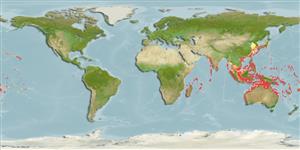Common names from other countries
Environment: milieu / climate zone / depth range / distribution range
Ekologi
marina; brackvatten revassocierade; djupintervall 1 - 75 m (Ref. 9710). Tropical; 43°N - 32°S, 31°E - 168°W
Indo-Pacific: East Africa eastward through northern Australia extending to Samoa; north to southern Japan.
Size / Vikt / Age
Maturity: Lm ? range ? - ? cm
Max length : 50.0 cm TL hane/ej könsbestämd; (Ref. 2334)
Taggstrålar i ryggfenan (totalt) : 3; Mjukstrålar i ryggfenan (totalt) : 25 - 27; Taggstrålar i analfenan: 0; Mjukstrålar i analfenan: 21 - 27; Ryggkotor: 18. Unique color pattern of large white spots on belly, black spots on yellow background on the back, yellow snout. A white or yellowish band across snout in front of eye. Lips and the area around mouth orange-yellow. A broad vertical white, slightly yellowish band on caudal fin. Scales enlarged above pectoral-fin base and just behind gill opening to form a flexible tympanum. Rows of small anteriorly projecting spines on caudal peduncle. A prominent groove extending anteriorly from front of eye for a distance of about 1 eye diameter. Mouth terminal. Caudal peduncle compressed (Ref 9770). 39-50 rows of plate-like scales.
Lives in clear coastal to outer reef habitats (Ref. 48637). Occurs in clear seaward reefs adjacent to steep drop-offs. A solitary species (Ref. 9710). Uncommon to rare throughout most of its range (Ref. 9770). Adults usually seen along deep drop-offs, swimming about openly and may retreat to caves when approached. Juveniles secretive in small caves with rich invertebrate growth (Ref. 48637). Diet consists of sea urchins, crabs and other crustaceans, mollusks, and tunicates (Ref. 9770). Marketed fresh (Ref. 9770). Among the most highly prized aquarium fishes (Ref. 1602).
Life cycle and mating behavior
Maturities | Reproduktion | Spawnings | Egg(s) | Fecundities | Larver
Distinct pairing (Ref. 205). Spawning occurs in patches of mixed coral rubble and sand on clear seaward reefs (Ref. 37816).
Matsuura, K., 2001. Balistidae. Triggerfishes. p. 3911-3928. In K.E. Carpenter and V. Niem (eds.) FAO species identification guide for fishery purposes. The living marine resources of the Western Central Pacific. Vol. 6. Bony fishes part 4 (Labridae to Latimeriidae), estuarine crocodiles. FAO, Rome. (Ref. 9770)
IUCN Red List Status (Ref. 130435)
CITES (Ref. 128078)
Not Evaluated
Threat to humans
Reports of ciguatera poisoning (Ref. 4690)
Human uses
Fiskeri: mindre kommeriell; Akvarium: Kommersiell
Verktyg
Special reports
Download XML
Internet-källor
Estimates based on models
Preferred temperature (Ref.
115969): 23.3 - 28.8, mean 27.3 (based on 552 cells).
Phylogenetic diversity index (Ref.
82804): PD
50 = 0.7500 [Uniqueness, from 0.5 = low to 2.0 = high].
Bayesian length-weight: a=0.02570 (0.01232 - 0.05364), b=2.94 (2.77 - 3.11), in cm Total Length, based on LWR estimates for this (Sub)family-body shape (Ref.
93245).
Trofisk nivå (Ref.
69278): 3.3 ±0.39 se; based on food items.
Resiliens (Ref.
120179): Mellan, lägsta populationsfördubblingstid 1,4-4,4 år (Preliminary K or Fecundity.).
Fishing Vulnerability (Ref.
59153): Moderate vulnerability (40 of 100).
